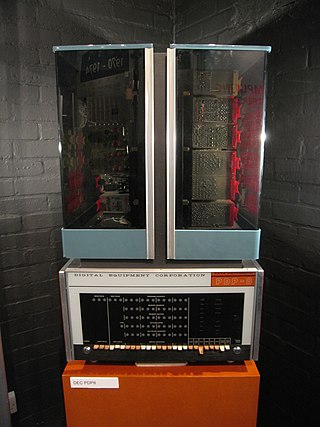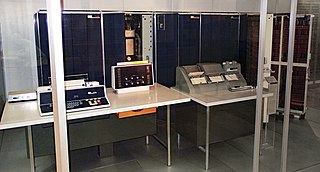Related Research Articles

In computer architecture, a bus is a communication system that transfers data between components inside a computer, or between computers. This expression covers all related hardware components and software, including communication protocols.

A microcontroller or microcontroller unit (MCU) is a small computer on a single integrated circuit. A microcontroller contains one or more CPUs along with memory and programmable input/output peripherals. Program memory in the form of NOR flash, OTP ROM or ferroelectric RAM is also often included on chip, as well as a small amount of RAM. Microcontrollers are designed for embedded applications, in contrast to the microprocessors used in personal computers or other general purpose applications consisting of various discrete chips.

The PDP-8 is a family of 12-bit minicomputers that was produced by Digital Equipment Corporation (DEC). It was the first commercially successful minicomputer, with over 50,000 units being sold over the model's lifetime. Its basic design follows the pioneering LINC but has a smaller instruction set, which is an expanded version of the PDP-5 instruction set. Similar machines from DEC are the PDP-12 which is a modernized version of the PDP-8 and LINC concepts, and the PDP-14 industrial controller system.

The PDP–11 is a series of 16-bit minicomputers sold by Digital Equipment Corporation (DEC) from 1970 into the late 1990s, one of a set of products in the Programmed Data Processor (PDP) series. In total, around 600,000 PDP-11s of all models were sold, making it one of DEC's most successful product lines. The PDP-11 is considered by some experts to be the most popular minicomputer.

The IBM System/360 (S/360) is a family of mainframe computer systems that was announced by IBM on April 7, 1964, and delivered between 1965 and 1978. It was the first family of computers designed to cover both commercial and scientific applications and a complete range of applications from small to large. The design distinguished between architecture and implementation, allowing IBM to release a suite of compatible designs at different prices. All but the only partially compatible Model 44 and the most expensive systems use microcode to implement the instruction set, featuring 8-bit byte addressing and fixed point binary, fixed point decimal and hexadecimal floating-point calculations.

A microcomputer is a small, relatively inexpensive computer having a central processing unit (CPU) made out of a microprocessor. The computer also includes memory and input/output (I/O) circuitry together mounted on a printed circuit board (PCB). Microcomputers became popular in the 1970s and 1980s with the advent of increasingly powerful microprocessors. The predecessors to these computers, mainframes and minicomputers, were comparatively much larger and more expensive. Many microcomputers are also personal computers. An early use of the term "personal computer" in 1962 predates microprocessor-based designs. (See "Personal Computer: Computers at Companies" reference below). A "microcomputer" used as an embedded control system may have no human-readable input and output devices. "Personal computer" may be used generically or may denote an IBM PC compatible machine.

Computer operating systems (OSes) provide a set of functions needed and used by most application programs on a computer, and the links needed to control and synchronize computer hardware. On the first computers, with no operating system, every program needed the full hardware specification to run correctly and perform standard tasks, and its own drivers for peripheral devices like printers and punched paper card readers. The growing complexity of hardware and application programs eventually made operating systems a necessity for everyday use.
In computing, a block, sometimes called a physical record, is a sequence of bytes or bits, usually containing some whole number of records, having a maximum length; a block size. Data thus structured are said to be blocked. The process of putting data into blocks is called blocking, while deblocking is the process of extracting data from blocks. Blocked data is normally stored in a data buffer, and read or written a whole block at a time. Blocking reduces the overhead and speeds up the handling of the data stream. For some devices, such as magnetic tape and CKD disk devices, blocking reduces the amount of external storage required for the data. Blocking is almost universally employed when storing data to 9-track magnetic tape, NAND flash memory, and rotating media such as floppy disks, hard disks, and optical discs.

The IBM 305 RAMAC was the first commercial computer that used a moving-head hard disk drive for secondary storage. The system was publicly announced on September 14, 1956, with test units already installed at the U.S. Navy and at private corporations. RAMAC stood for "Random Access Method of Accounting and Control", as its design was motivated by the need for real-time accounting in business.

CMS-2 is an embedded systems programming language used by the United States Navy. It was an early attempt to develop a standardized high-level computer programming language intended to improve code portability and reusability. CMS-2 was developed primarily for the US Navy’s tactical data systems (NTDS).
In computer science, a data buffer is a region of a memory used to store data temporarily while it is being moved from one place to another. Typically, the data is stored in a buffer as it is retrieved from an input device or just before it is sent to an output device. However, a buffer may be used when data is moved between processes within a computer. That is comparable to buffers in telecommunication. Buffers can be implemented in a fixed memory location in hardware or by using a virtual data buffer in software that points at a location in the physical memory.

IBM 7070 is a decimal-architecture intermediate data-processing system that was introduced by IBM in 1958. It was part of the IBM 700/7000 series, and was based on discrete transistors rather than the vacuum tubes of the 1950s. It was the company's first transistorized stored-program computer.
The AN/UYK-20 "Data Processing Set" was a ruggedized small computer manufactured by Univac and used by the United States Navy for small and medium-sized shipboard and shore systems built in the 1970s. It featured non-volatile magnetic core memory and was housed in a heavy-duty metal cube-shaped box which was designed to fit through a 25-inch circular hatch.
The AN/UYK-7 was the standard 32-bit computer of the United States Navy for surface ship and submarine platforms, starting in 1970. It was used in the Navy's NTDS & Aegis combat systems and U.S. Coast Guard, and the navies of U.S. allies. It was also used by the U.S. Army.

Computer hardware comprises the physical parts of a computer, such as the central processing unit (CPU), random access memory (RAM), motherboard, computer data storage, graphics card, sound card, and computer case. It includes external devices such as a monitor, mouse, keyboard, and speakers.

In computing, input/output is the communication between an information processing system, such as a computer, and the outside world, such as another computer system, peripherals, or a human operator. Inputs are the signals or data received by the system and outputs are the signals or data sent from it. The term can also be used as part of an action; to "perform I/O" is to perform an input or output operation.
This glossary of computer hardware terms is a list of definitions of terms and concepts related to computer hardware, i.e. the physical and structural components of computers, architectural issues, and peripheral devices.
ICT 1900 was a family of mainframe computers released by International Computers and Tabulators (ICT) and later International Computers Limited (ICL) during the 1960s and 1970s. The 1900 series was notable for being one of the few non-American competitors to the IBM System/360, enjoying significant success in the European and British Commonwealth markets.

The IBM System/360 Model 20 is the smallest member of the IBM System/360 family announced in November 1964. The Model 20 supports only a subset of the System/360 instruction set, with binary numbers limited to 16 bits and no floating point. In later years it would have been classified as a 16-bit minicomputer rather than a mainframe, but the term "minicomputer" was not current, and in any case IBM wanted to emphasize the compatibility of the Model 20 rather than its differences from the rest of the System/360 line. It does, however, have the full System/360 decimal instruction set, that allows for addition, subtraction, product, and dividend of up to 31 decimal digits.
The AN/AYK-14(V) is a family of computers for use in military weapons systems. It is a general-purpose 16-bit microprogrammed computer, intended for airborne vehicles and missions. Its modular design provides for common firmware and support software. It is still in use on Navy fleet aircraft including the F/A-18, and the AV-8B. The AN/AYK-14(V) family of systems is designed to meet MIL-E-5400 (airborne) requirements.
References
- 1 2 "IT Legacy, Milestones". Archived from the original on April 2, 2012.
- ↑ "AN/UYK-43 Computer". Archived from the original on December 1, 2011.
- ↑ "Logistics Support for Legacy Systems: Tactical Embedded Computer Resource Reutilization". Archived from the original on March 6, 2001.